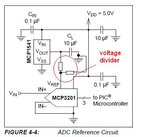Ma3ix
Member level 2
Hi,
can someone explain me relation between Vref vs LSB error cause Im a bit confused with datasheet of ADC.
Im using LM35 sensor for temperature measuring and ADC MCP 3004 for analog-digital conversion.
-------------
Vdd is 5V.
- if I use Vref = 5V then I dont have problems with LSB error, in other words readings from voltage instrument and display for temperature are coincides.
The problem is that I wanna better LSB size than 5/1024 ~ 0.5 mV which is 0.5 Celsius degress.
- when I decrease Vref than i have this results:
1) Vref = 1.307V; instrument reading :288mV; display reading: 298
This give me error of 1 Celsius degree. LSB size is 1.307V/1024= 1.276 mV so for 1 celsius degree I have to reduce output from ADC for about 8 LSB.
2) Vref = 0.933V; instrument reading :287mV; display reading: 317
This give me error of 3 Celsius degrees. LSB size is 0.933V/1024= 0.9 mV so for 3 celsius degree (317-287=30mV) I have to reduce output from ADC for about 33 LSB.
Is there a way to calculate / predict LSB error according to Vref value?
From diagram characteristics of MCP3004 for Vref around 1~1.5V should be about few LSB error? Or Im not reading correctly the datasheet.
ADC datasheet: https://www.microchip.com/wwwproducts/en/MCP3004
Thanks.
can someone explain me relation between Vref vs LSB error cause Im a bit confused with datasheet of ADC.
Im using LM35 sensor for temperature measuring and ADC MCP 3004 for analog-digital conversion.
-------------
Vdd is 5V.
- if I use Vref = 5V then I dont have problems with LSB error, in other words readings from voltage instrument and display for temperature are coincides.
The problem is that I wanna better LSB size than 5/1024 ~ 0.5 mV which is 0.5 Celsius degress.
- when I decrease Vref than i have this results:
1) Vref = 1.307V; instrument reading :288mV; display reading: 298
This give me error of 1 Celsius degree. LSB size is 1.307V/1024= 1.276 mV so for 1 celsius degree I have to reduce output from ADC for about 8 LSB.
2) Vref = 0.933V; instrument reading :287mV; display reading: 317
This give me error of 3 Celsius degrees. LSB size is 0.933V/1024= 0.9 mV so for 3 celsius degree (317-287=30mV) I have to reduce output from ADC for about 33 LSB.
Is there a way to calculate / predict LSB error according to Vref value?
From diagram characteristics of MCP3004 for Vref around 1~1.5V should be about few LSB error? Or Im not reading correctly the datasheet.
ADC datasheet: https://www.microchip.com/wwwproducts/en/MCP3004
Thanks.
